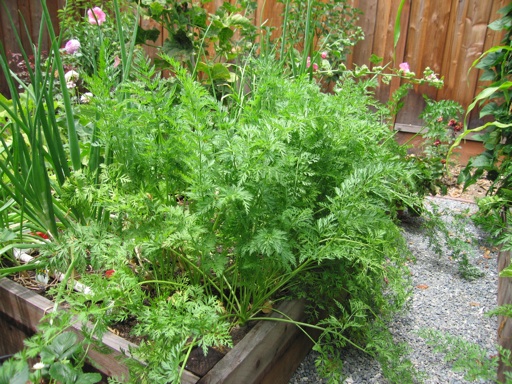

Carrots have been one of the most enjoyable vegetables to grow in our garden. Back in early April, I planted seeds for red, yellow, white, and purple carrots. Most of the seeds sprouted as extremely tiny seedlings, but they grew very fast. After 3 months, they have grown so large that they are crowding each other (see top picture).
Some of our carrots went to seed before they developed more than a tiny little carrot. But most of them have not seeded yet. Carrots are supposed to be a spring or fall crop, because they tend to go to seed too soon in hot summer weather. Perhaps our relatively mild summers (highs averaging around 80 F) have kept most of them from seeding prematurely.
Many of our carrots are ready to harvest. On the seed package, it says 65-75 days to maturity, but our carrots seem to be taking longer than that. Also, carrots appear to last in the ground for a long time without going bad or losing flavor.
I determine when carrots are ready to harvest by digging around the top of the root to see when the carrot appears to have grown to a full size. (see bottom picture) Harvesting carrots is very fun, because it’s always a surprise when you pull them up and find out how big they are.
July 18 2009 | Carrots | Comments Off on Carrot Patch
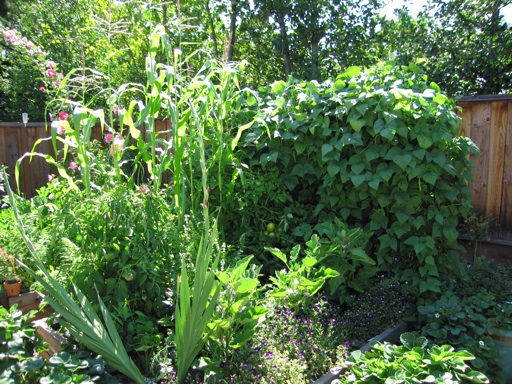
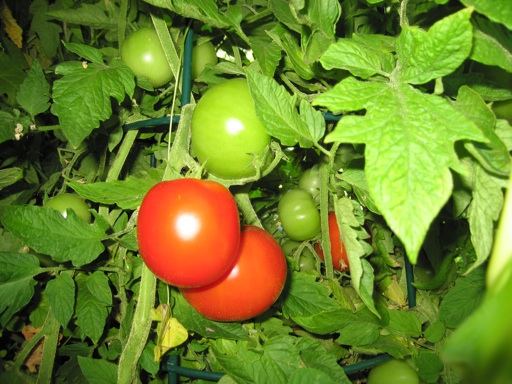
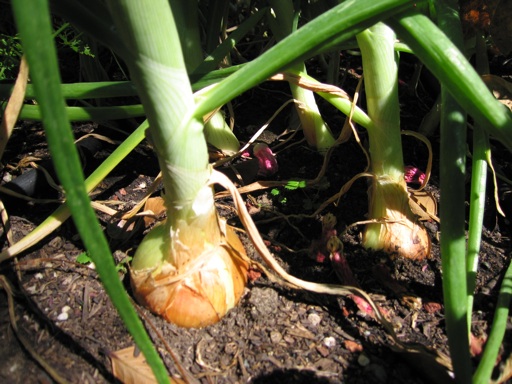
We have been growing vegetables in two 6′ x 7′ raised beds since last summer. In these two small beds, we are growing several different types of fruits and vegetables including peppers, eggplant, zucchini, green beans, tomatoes, corn, carrots, onions, cantaloupe, and honey dew.
Our most successful plants so far are the green beans and zucchinis. They are producing more green beans and zucchinis than we can eat. Only a few of the tomatoes on our two tomato plants are have ripened so far (see second picture), but there are dozens of green tomatoes hanging on the vines.
Several of our carrots and onions are just about ready to harvest. The third picture shows some of the walla walla onions we are growing this season. Our corn stalks have reached their maximum height and are now starting to grow small corn ears.
Our eggplants and peppers are growing several small fruits. Although the peppers have not grown very much since I planted them in April. They seem to be getting crowded by the beans, carrots, and tomatoes growing next to them. One of the problems with growing so many different types of plants in a small area is that the slow growing plants like peppers and eggplant tends to get crowded by the faster growing plants. Next year, I may try to plant the slower growing plants together in one bed and the faster growing plants in the other bed.
I haven’t fertilized most of the plants in our vegetable garden since mid-May. I was fertilizing them with water soluble fertilizer for about the first 6 six weeks after planting. After that, most of the vegetables started growing so fast that I decided to stop the fertilizing. I have only been continuing to fertilize the eggplants and peppers in an attempt to get them to grow more.
I have also been fertilizing our strawberries about once a week. I know that sounds like a lot of fertilizer, but they have been producing strawberries continuously since early May. They show no signs of slowing down their fruit production yet. I have been harvesting a small bowl full of berries every few days for over two months. I attribute the huge production of berries to all the fertilizer. Last year, they stopped producing berries in early June. But as soon as I started fertilizing them, they begin to produce berries again.
Our strawberries are growing in pots around the raised beds, which makes it easy to pick them. Strawberries tend to rot quickly when the fruits are lying directly on damp soil. The berries mostly hang over the edges of the pots, so the berries stay dry.
July 12 2009 | Onions and Strawberries and Tomatoes and Vegetables | Comments Off on Vegetable Garden Update

We have three orchids that are growing indoors in pots. Initially, my partner was feeding our orchids with a 20-20-20 water soluble orchid fertilizer every 7-14 days. He would add about a tablespoon of the fertilizer to a water bath in our kitchen sink and soak the pots in it for 5-10 minutes. The orchids were growing slowing and generating flowers.
About 4 months ago, I learned that the 20-20-20 fertilizer tends to stimulate new growth and that an orchid bloom fertilizer will be more likely to simulate flower production. So I purchased an orchid 6-30-30 water soluble orchid bloom fertilizer. I started adding half a tablespoon of the 20-20-20 fertilizer and about half a tablespoon of the 6-30-30 bloom fertilizer to the water bath before soaking the orchids for about 15-30 minutes. I am now fertilizing/watering them every 2 weeks.
Since I started giving our orchids the bloom formula and soaking them for a longer time, our orchids have been generating many more flowers. Our white orchid in the above picture started growing a new stem of flowers off of a flower stem that has been blooming since March. It now has over 20 flowers open at once. The first flowers on this stem that opened in March (see my April 11 post) are still open and show no signs of wilting yet.
July 05 2009 | Orchids | Comments Off on Orchid Bloom Fertilizer
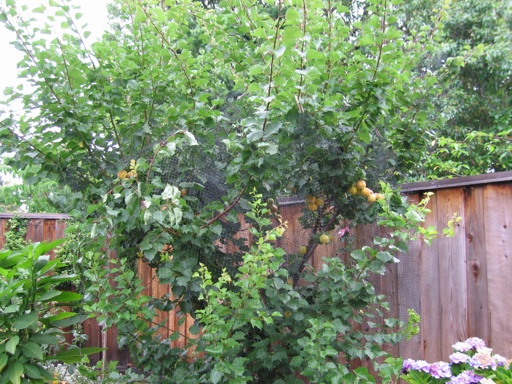
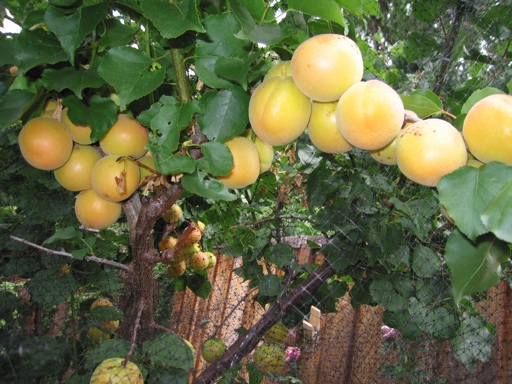
Yesterday, my mom came over to our house to help me harvest my first batch of Blenheim apricots of the year from the above pictured tree in our yard. We both love the taste of tree ripened Blenheim apricots. They seem to be the most flavorful apricot. My parents have a 30+ year old Blenheim apricot tree in their yard that is still producing quality fruit.
My tree is now 7 years old. Its fruit are large and have a very good flavor. They are much better tasting than the grocery store apricots I have eaten. Although, we both think that the fruit from my parents’ 30+ year old tree is much sweeter than the fruit from my young tree. Their apricots taste like a dessert. My guess is that a mature apricot tree has a greater ability than a young tree to generate sugars and produce sweeter fruits.
I have had to build a virtual fortress of bird netting around my apricot tree to keep the birds and squirrels from eating the fruit. So far, I have lost only a few fruits to the wildlife. I wrapped bird netting around all sides of the tree up to the upper weak branches and then tied it tightly around the bottom with string leaving no openings around the sides or the bottom for the squirrels to crawl through. I loosely draped the netting through the high branches to keep the birds from flying inside. This netting technique has mostly kept the bird and squirrels out.
A few days ago, I peeled away the netting to pick a few apricots and then didn’t reseal the netting tightly enough after I was finished. By the time I was back inside our kitchen, a squirrel had already found its way inside the netting. After shooing it away, I wrapped two extra nets around the tree for a total of 3 nets. There hasn’t been any more breaches since then. The two week period when apricots are ripening in late June and early July is the most important time to net. That’s when the birds and squirrels seem to to go after them the most.
July 02 2009 | Apricots | Comments Off on Harvesting Blenheim Apricots
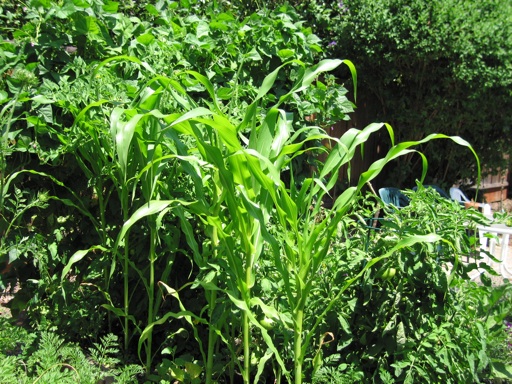
I planted the corn in this picture back in mid-April when it was about two inches high. Corn has been one of the fastest growing plants in our raised bed vegetable garden this year. It has grown particularly fast in the past month. It is already about four feet tall, even though it’s getting crowded by nearby tomato and bean plants that I planted the corn too close to. The fastest growing plants in our garden this year have been pole beans (behind the corn in the picture), corn, tomatoes, and zucchini.
I planted a sweet white variety of corn this year. I tend to prefer the white corn varieties over the yellow corn varieties, because I have found that white corn is usually sweeter. Last year, I grew a bi-colored yellow and white corn variety which turned out to be very flavorful and buttery.
Our tomatoes and beans are also growing vigorously and crowding our nearby peppers and eggplants. The peppers and eggplants haven’t been growing very much. I think that’s because they are not getting enough sun. Perhaps, they don’t have enough root space either. I really underestimated how large some of these fruit/vegetables would get. Next year, I will try to have more restraint by setting out fewer plants.
June 28 2009 | Corn | Comments Off on Fast Growing Corn
« Prev - Next »








